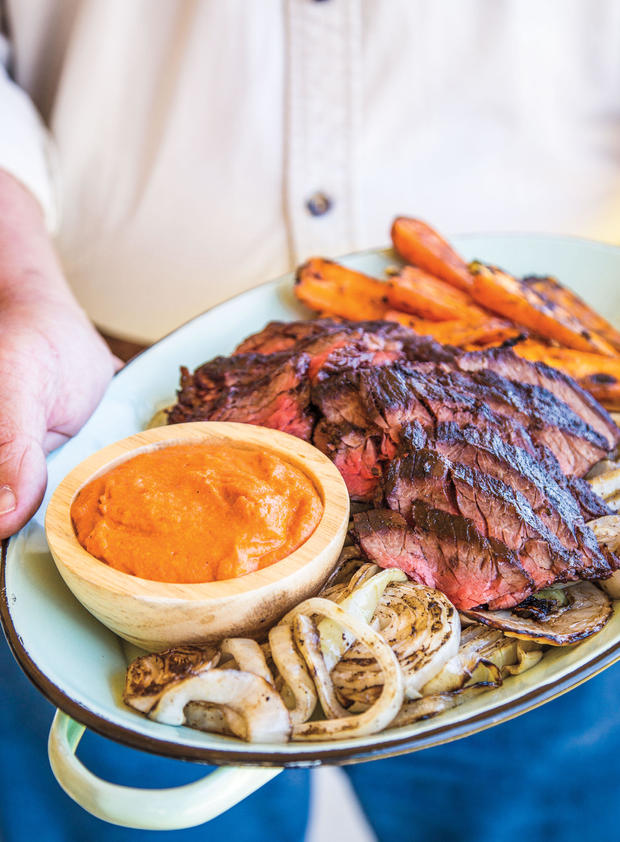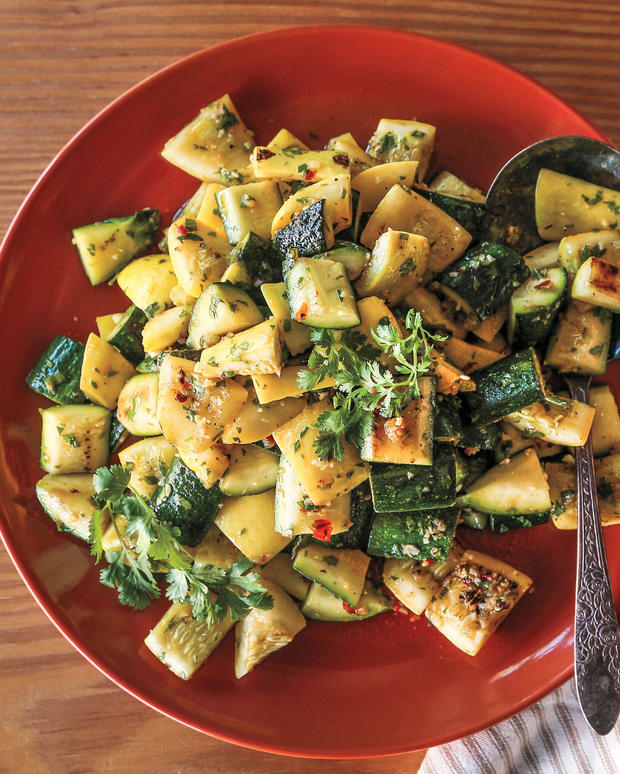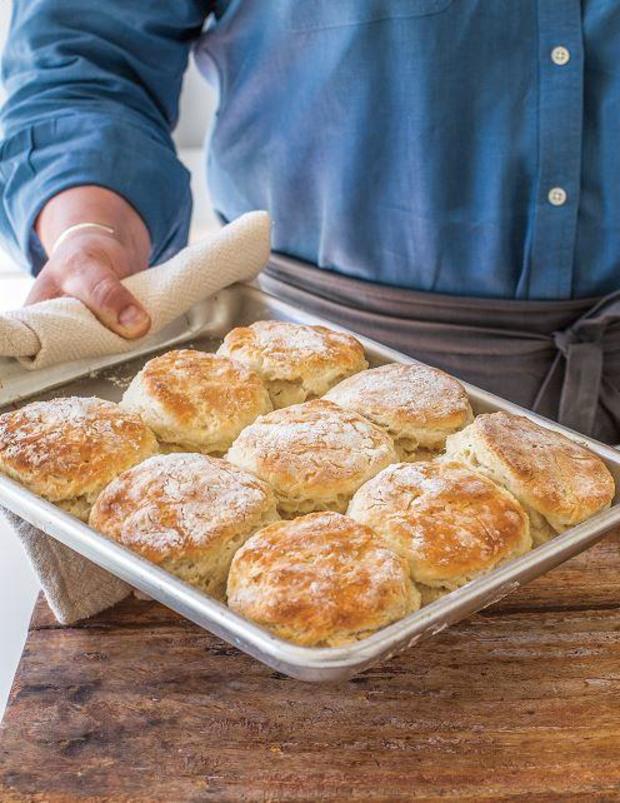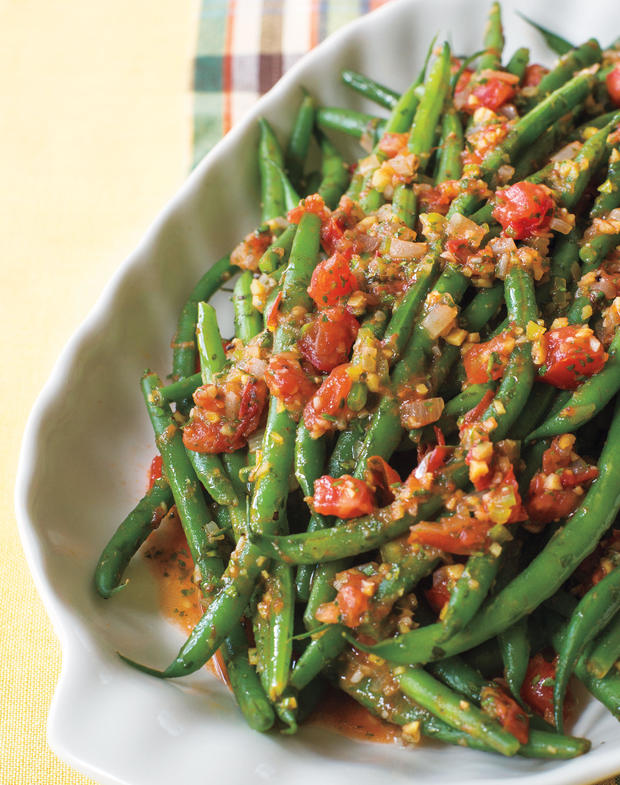The Dish: Virginia Willis' recipes from "Secrets of the Southern Table"
Born in Augusta, Georgia, Virginia Willis loved her grandmother's Southern classics. When her family moved to Louisiana, she fell for Cajun cooking, too. After college and culinary schools in the U.S. and France, she began a multifaceted career as a chef, cooking show producer and prolific author of six cookbooks – including a winner of the James Beard Award. Her latest, "Secrets of the Southern Table," was published just this month.
Here are some of Willis' recipes from "Secrets of the Southern Table":
Garlic-Rubbed Skirt Steak and Vidalia Onions with Pecan Romesco
You can also substitute the pecans with peanuts in this recipe.
In this age of seasonless grocery stores, where strawberries and squash are always available, Vidalia onions remain a spring treat, with a harvest from late April through mid-June. Every spring, without fail, many Southerners buy a big mesh sack of these sweet onions and store them knotted in pantyhose in a cool, dry place for as long as they'll last. Here their unique sweetness provides a great complement to rich steak and tangy romesco sauce. The sauce makes about 2 cups and can be easily doubled for a crowd.
Skirt steak is a thin, long cut of beef from the diaphragm muscles of the cow (when purchasing, you may need more than one steak, as they are generally sold in pieces). It is very lean and fibrous with an intense beefy flavor, and is often used in fajitas (the Spanish word fajita means "belt" or "cummerbund," referring to the long belt-like shape of the steak). Skirt steak is best cooked over very high heat and should only be cooked to rare or medium-rare for the tenderest texture; when you serve, cut across the grain of the meat. You may use other steaks such as flank or hanger in this recipe with equally delicious results.
Serves 4 to 6
Ingredients
For the steak:
2 pounds skirt, hanger, or flank steak
6 garlic cloves, mashed to a paste with salt (see page 22)
2 tablespoons pure olive oil
2 or 3 large sweet onions, preferably Vidalia, sliced
For the romesco sauce:
½ cup roasted pecans
1 (12-ounce) jar roasted red bell peppers
½ cup tomato puree
2 garlic cloves, plus more for garnish
1 slice country white bread, toasted and crumbled
1 tablespoon smoked paprika
1/3 cup sherry vinegar
2/3 cup extra-virgin olive oil, plus more for garnish
Coarse kosher salt and freshly ground black pepper
Directions
- To prepare the steak, using paper towels, pat the steak dry and place in a large bowl; slather the garlic paste and olive oil all over meat, turning to coat. Add the onions. Cover and refrigerate for at least 30 minutes or up to overnight.
- To make the romesco sauce, grind the peanuts in a food processor. Add the roasted peppers, tomato puree, garlic, bread, and paprika. Process into a paste. Add the vinegar and pulse to blend. With the motor running, gradually pour the oil through the feed tube in a steady stream until the mixture thickens like mayonnaise. Taste and adjust for seasoning with salt and pepper and then transfer to a serving bowl.
- When ready to grill the steak, scrape any excess garlic off the beef and discard. If using a charcoal grill, prepare the fire using about 6 pounds of charcoal and burn until the coals are completely covered with a thin coating of light gray ash, 20 to 30 minutes. Spread the coals evenly over the grill bottom, position the grill rack above the coals, and heat until medium-hot (when you can hold your hand 5 inches above the grill surface for no longer than 3 or 4 seconds). If using a gas grill, turn all the burners to High, close the lid, and heat until about 500°F, 10 to 15 minutes. If using a grill pan, heat the pan over medium-high heat.
- Grill the meat and onions over direct heat until char lines appear, the meat is done to taste, and the onions are tender and charred, 3 to 5 minutes per side. Let rest for 5 minutes before slicing the meat across the grain. Serve the steak and onions with the romesco sauce on the side.
Pan-Seared Summer Squash with Spiced Lemon Vinaigrette
Summer squash thrive in the semitropical South. My grandparents always had a garden with many mounded rows of squash, and my grandfather taught me that summer squash bear both male and female flowers. The female flowers are easy to identify by looking for a miniature squash just below each blossom. Male flowers sit directly on the stem and do not produce fruit. Pick these male blossoms for using the flower. If you pick the females, you won't have any squash. Simple biology. This dish was inspired by chef-owner Rafih Benjelloun of Imperial Fez, a beloved Atlanta institution for more than twenty-five years. At his restaurant, guests are magically transported to Morocco—the tea is mint, not sweet; diners rest on comfortable pillows surrounded by opulent colors; shoes are left at the door; and belly dancers dance and sway to the music.
Serves 4 to 6
Ingredients
3 or 4 small yellow squash (about 1 pound)
3 or 4 small green squash (about 1 pound)
Zest of 1 lemon and juice of ½ lemon
2 tablespoons extra-virgin olive oil
3 garlic cloves, mashed to a paste with a pinch of salt (see note, page 22)
1 teaspoon harissa or chile paste, or to taste
¼ teaspoon ground cumin
Coarse kosher salt and freshly ground black pepper
2 tablespoons chopped fresh parsley
Directions
- Trim the stem and flower ends of the squash, and then use a chef's knife to quarter each one lengthwise. Using the tip of your knife, trim away the seeds. (The seeds can make the dish watery.) Cut the squash into 1-inch pieces.
- Heat a large nonstick skillet over medium-high heat. Without crowding, add the squash to the dry skillet and cook, stirring often, until lightly blistered on both sides and tender to the point of a knife, 5 to 7 minutes.
- Meanwhile, in a small bowl or jar with a lid, combine the lemon zest, lemon juice, oil, garlic, harissa, and cumin to make the dressing. Stir or shake to combine. Season with salt and pepper.
- Place the squash in a large bowl and drizzle some of the dressing over the top. Toss to coat and combine, and add more as needed. Sprinkle with the parsley. This dish is excellent served hot or room temperature or cold as a salad. If you serve it cold, make sure to taste and adjust for seasoning with salt and pepper before serving, as chilling dulls the seasoning.
Harissa is a spicy, aromatic, and flavorful chile paste used in Middle Eastern and North African cooking. The blend differs from country to country, but it's a puree of hot chile peppers, garlic, olive oil, and spices such as cumin, coriander, and caraway. It can be found at Middle Eastern markets, well-stocked gourmet stores, and natural foods stores.
To prepare the garlic paste, place the unpeeled garlic on a cutting board, broad-side down, set the flat side of a chef's knife on top, and give the knife a quick whack with the palm of your hand to crush each clove. Remove the papery skin and trim away the tough basal plane at the end of the clove. Halve the garlic and remove any of the green shoot, if present, as it is bitter. Coarsely chop the garlic, then sprinkle it with a pinch of coarse salt. (The salt acts as an abrasive and helps grind the garlic.) Using the side of the knife like an artist's palette knife, press firmly on the cutting board and crush the garlic a little at a time. Repeat until the garlic is a fine paste.
Cathead Biscuits
My friend and colleague Dr. Marcie Cohen Ferris is a professor in the Department of American Studies at the University of North Carolina. Her research and teaching interests include Southern history and culture—particularly the foodways and material culture of the American South and the history of the Jewish South. In her excellent book The Edible South she writes, "In contemporary worlds of popular and consumer culture, Southern food has become untethered from the complex historical narrative responsible for this cuisine. Think of buckets of Southern fried chicken and cathead biscuits like culinary spacecraft set adrift from the mother ship of southern history, culture, and experience." I wholeheartedly agree. Many people outside the South think all Southern food is unhealthy and/or fried.
The term cathead biscuit is an authentic one, indicating that it's a biscuit as large as a cat's head, and a phrase my grandfather once used. This extra-large biscuit would not have been the norm on the everyday table, but it has become the standard size for fast-food biscuits. Ferris continues, "Fried chicken, biscuits, and sweet tea—the icons of Southern food—have become so 'super-sized,' enriched, sweetened, and filled with butter that they are almost unrecognizable to native Southerners." This cathead biscuit is the real deal.
There are a few secrets to a tender biscuit: First, flours vary in their protein levels. Reach for a low-protein flour for light-as-air biscuits. After that, you want cold butter—when the cold butter is transferred to the hot oven it melts and produces steam, which helps produce flaky biscuits. Lastly, avoid overworking the dough, which activates the gluten and will produce a tough, heavy biscuit. The perfect biscuit should be golden brown and slightly crisp on the outside, with a light, airy interior.
Makes about 9
Ingredients
4 cups White Lily or other Southern all-purpose flour, or cake flour (not self-rising), plus more for rolling out
2 tablespoons baking powder
2 teaspoons fine sea salt
8 tablespoons (½ cup) cold unsalted butter, cut into cubes and chilled
2 cups buttermilk
Directions
- Heat the oven to 500°F. Line a baking sheet with a silicone baking mat. (You can also bake the biscuits on an ungreased baking sheet.)
- In a bowl, combine the flour, baking powder, and salt. Using a pastry blender or two knives, cut the butter into the flour mixture until it resembles coarse meal. Pour in the buttermilk and mix until just barely combined. It will be a shaggy mass. (Alternatively, you can mix the dough in a food processor: Pulse to combine the flour, baking powder, and salt.
- Add the butter and pulse until it resembles coarse meal. Pour in the buttermilk through the feed tube and pulse until just barely combined. It will be a shaggy mass.)
- Turn the shaggy mass out onto a lightly floured surface. Knead lightly, using the heel of your hand to compress and push the dough away from you, then fold it back over itself. Give the dough a small turn and repeat four or five times. (It's not yeast bread; you want to just barely activate the gluten, not overwork it.)
- Using a lightly floured rolling pin, roll the dough out 1 inch thick. Cut out rounds of dough with a 3½-inch round cutter dipped in flour; press the cutter straight down without twisting so the biscuits will rise evenly when baked.
- Place the biscuits on the prepared baking sheet. If the biscuits are baked close together, the sides will be tender. If the biscuits are baked farther apart, the sides will be crisp. (I always say biscuits are like people: If you are close to your neighbor, you will be tender, and if you aren't close to your neighbor, you will be crisp!)
- Once you've punched out the first round from the dough, you can reroll the scraps. However, do not simply roll them into a ball; this will create a knot of gluten strands. Instead, place the pieces one on top of the other in layers. Then roll out and repeat punching out the biscuits.
- Bake until golden brown, 10 to 12 minutes. Transfer to a rack to cool just slightly. Serve warm.
Wheat flour contains two proteins, glutenin and gliadin. Gluten is a strong and elastic sheet produced by these proteins by the combination of moisture and motion. When you combine flour with liquid, the proteins produce gluten. Gluten gives structure and chewiness to yeast breads, but you don't want to develop gluten in tender biscuits.
Tomato-Ginger Green Beans
Green beans are also known as string beans or snap beans and are traditionally simmered for a long time with a hunk of some kind of pork—bacon, fat back, or hog jowl. My grandfather could eat a mountain of green beans and planted his garden accordingly. My grandmother would cook them in her pressure cooker, which would transform them from a bright green, crisp vegetable into soft-as-silk, army-green vegetable noodles. I remember the safety valve emitting little bursts of steam and the meaty, vegetal aroma that filled the air. There's always going to be a place in my heart and at my table for those old-fashioned Southern recipes, even as I appreciate the influences on Southern food and cooking from different cuisines and cultures.
Tomatoes are actually a fruit, not a vegetable, and marry particularly well with spicy ginger in this dish. While most ginger is imported, the sandy soil and hot climate of the Southeast is conducive to growing ginger, and a number of farmers are adding both it and turmeric to their crop rotation. And no, it's not a typo. I'm suggesting ¼ cup chopped ginger in this Southeast Asian–inspired side dish.
Serves 4 to 6
Ingredients
1 pound string beans (French-style haricots verts work especially well), stem ends trimmed
1 tablespoon canola oil
1 shallot, finely chopped
¼ cup very finely chopped fresh ginger
4 garlic cloves, finely chopped
2 tomatoes, cored, seeded, and chopped
½ jalapeño, or to taste, seeded and chopped
¼ cup chopped fresh cilantro
Coarse kosher salt and freshly ground black pepper
Directions
- Bring a large pot of salted water to a rolling boil over high heat. Fill a large bowl with ice and water and set it nearby. Line a plate with paper towels.
- Add the beans to the boiling water and cook until crisp-tender, about 3 minutes. Drain well in a colander and then set the colander with the beans in the ice-water bath to set the color and stop the cooking, making sure the beans are submerged. Once chilled, transfer the beans to the prepared plate. Pat dry with paper towels and then transfer to a bowl.
- Heat the oil in a large skillet over medium-high heat. Add the shallot and cook until tender, about 3 minutes. Add the ginger and garlic and cook until fragrant, 45 to 60 seconds. Add the tomatoes and jalapeño and cook until warmed through, 5 minutes.
- Add the cooked green beans and toss to coat and combine. Cook, tossing and stirring, until the green beans are heated through, 3 to 5 minutes. Add the cilantro; taste and adjust for seasoning with salt and pepper. This dish is delicious served hot, warm, room temperature, or cold. If served cold, make sure to taste and adjust for seasoning with salt and pepper, as chilling a dish dulls the seasoning.
Peach Upside-Down Cake
Southern peaches are something special. The trouble is, you pretty much have to live in the South to understand what the fuss is about, because peaches bought elsewhere are most often picked green and hard before shipping. When ag-entrepreneur Stephen Rose moved to Nashville in the summer of 2010, he made a disheartening discovery: No one was selling fresh, flavorful peaches like the kind he'd grown up with in Peach County, Georgia. He had an idea. He and his wife bought a 1964 Jeep truck and started selling big, beautiful, juicy Georgia peaches out of their cab in Nashville. Within five weeks, the city had consumed over ten tons of their brown-bagged peaches. Now the Peach Truck Tour travels through Tennessee, Kentucky, Ohio, Indiana, and Pennsylvania!
Pineapple upside-down cake is a Southern classic and is most often made with canned pineapple. This version uses fresh peaches and is a vast improvement, in my opinion. You can use all-purpose flour instead of the cake flour, but the results will be a bit heavier and slightly dense.
Serves 10
Ingredients
4 medium peaches (about 1½ pounds), unpeeled and cut into ⅓ -inch-thick wedges
Juice of 1 lemon
1 cup cake flour, not self-rising
¾ teaspoon baking powder
¼ teaspoon baking soda
1 cup granulated sugar
10 tablespoons (½ cup plus 2 tablespoons) unsalted butter, at room temperature
1 vanilla bean, split and seeds scraped
2 large eggs
½ cup sour cream
Bourbon Cream (recipe below)
Directions
- Heat oven to 350ºF. Line a rimmed baking sheet with a silicone baking mat or parchment paper. (This step helps with cleanup.)
- Toss the peaches with the lemon juice in a large bowl. In a separate bowl, whisk together the flour, baking powder, and baking soda.
- Cook ¼ cup of the granulated sugar over medium heat in a 10-inch cast-iron skillet, stirring occasionally with a wooden spoon, for 10 minutes, or until the sugar melts and turns a deep amber color. Remove from the heat. Immediately add 2 tablespoons of the butter and stir vigorously. Arrange the peach wedges in concentric circles over the sugar mixture, overlapping them as needed.
- In the bowl of a stand mixer fitted with the paddle attachment, beat the remaining ¾ cup granulated sugar, ½ cup butter, and vanilla bean seeds on medium speed until smooth. Add the eggs, one at a time, beating until blended after each addition. Add the sour cream and beat until blended. With the mixer running on low speed, gradually add the flour mixture, beating just until blended and stopping to scrape bowl as needed. Spoon the batter over the peaches in the skillet and spread to cover. Place the skillet on the prepared baking sheet.
- Bake until golden brown and a wooden toothpick inserted into the center of the cake comes out clean, 40 to 45 minutes. Let cool in the skillet on a wire rack for 10 minutes. Run a knife around edge to loosen.
- Carefully pour out any excess liquid from the skillet into a measuring cup and set aside. (It's okay if you don't have any excess liquid—it all depends on how juicy your fruit is.) Carefully invert the cake onto a serving plate and drizzle with any reserved liquid. Let cool slightly, about 10 minutes. Cut into wedges using a serrated knife. Top with bourbon cream and serve immediately.
Bourbon Cream
Makes about 1 cup
Ingredients
½ cup heavy cream
1 tablespoon bourbon
Directions
Combine the cream and bourbon in a large bowl. Refrigerate, along with a whisk, for at least 15 minutes. Once chilled, beat the cream with the chilled whisk until it holds soft peaks, 3 to 5 minutes.
These recipes are excerpted from "Secrets of the Southern Table" © 2018 by Virginia Willis. Photography © 2018 by Angie Mosier. Reproduced by permission of Houghton Mifflin Harcourt. All rights reserved.








